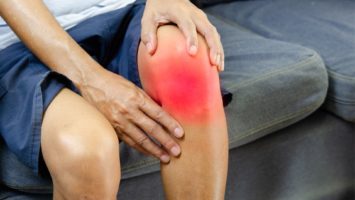
Tips for Knee Pain
Do you need tips for knee pain?
Knee pain can really cramp your style and your workouts.
Sadly, many athletes and non-athletes alike experience knee pain at some point in their lives. The knee joint is also a common injury site for many different sports.
Fortunately, the ten tips in this article can help you reduce knee pain or even prevent a future knee injury.
Without further ado, let’s get started.
Get Evaluated
If your pain lasts longer than two weeks, you should always see a sports medicine doctor or physical therapist.
These experts can diagnose and treat you for a faster return to all your favorite activities.
Additionally, these professionals can provide you with the latest and most evidence-based treatment options to increase your chances of a full recovery.
Avoid Movements that Hurt
If running or lunging makes your pain worse, lay off that movement. Try to avoid anything that makes your pain worse.
You might be able to reintroduce those activities later on after completing a course of treatment, physical therapy, or after making changes to your form or technique.
For now, take out any obvious offenders that make your pain much worse.
Do Cardio
While you don’t want to do any activities that make your pain much worse, getting active can reduce pain and inflammation.
For instance, low impact cardio activities like swimming, using an elliptical or walking can improve your pain.
Make sure you warm up properly and avoid any jumping, pounding and high impact movements.
Use Ice
While icing your injuries might not increase healing, it can provide an analgesic effect.
After any activity that causes pain, try icing your knees for 15-20 minutes. Just make sure to put a barrier between your skin and the ice so you do not cause freezer burn.
Use Heat
Applying heat to your injuries might not increase healing, but it does feel good.
You can apply warm compresses to your knees for 15-20 minutes before activity. This practice might ease pain and increase range of motion, especially for the first few minutes of your exercise routine.
Try Strength Training
Strength training can help support your knee joints and prevent further pain and injury.
Exercises like quad sets, clam shells, glute bridges, hamstring curls, partial and full squats, and step ups can help you support strong and healthy knees.
Pay special attention to your glutes and hamstrings to help stabilize your knee joints and prevent further injury.
As your pain subsides and you return to your sport or favorite activity, incorporate more jumping and cutting drills and plyometrics to work on your landing mechanics. Good landing mechanics when jumping, weaving or cutting can help you prevent future knee pain or even a season ending injury like an ACL tear.
If you need help, enlist a qualified personal trainer to get started.
Lose Weight
You may have heard it before: every extra pound you carry puts about three extra pounds of pressure on your knees.
If you carry too much extra fat, losing some weight can reduce stress and pain in your knees. Even modest weight loss of 5 to 10 pounds can take a lot of stress off of your knees.
Try to lose weight in a slow, controlled fashion so you can keep it off successfully.
If you need help, enlist a quality nutrition coach to help you lose weight safely.
Improve your Diet
Switching to a heart healthy diet full of healthy fats and omega 3 fatty acids might even improve inflammation and pain levels.
Try to eat salmon, other fatty fish, avocados, nuts and seeds regularly. However, make sure you keep your portion sizes in check to prevent unnecessary weight gain.
Wear Good Shoes
Wearing supportive footwear can help reduce pain levels. In contrast, wearing heels and espadrille sandals can increase pain. While fashion forward shoes can elevate your look, they do little for your pain or alignment.
While you have knee pain, try to wear orthopedic shoes and supportive sneakers only.
You might also consider an evaluation by a gait specialist to help you find shoes and insoles that support your unique anatomy. Finally, make sure to replace your shoes every six months or at least rotate through a few pairs of quality shoes.
Improve Mobility
Sometimes poor flexibility and mobility can contribute to your pain levels. Unfortunately, tight ankles or hips can often lead to knee pain. By improving mobility and flexibility, you can take some strain off your knees. Try to stretch your ankles, hamstrings, quads and hips regularly to reduce strain on your knee joints.
Aim to warm up with light cardio for 5-10 minutes before trying 3-4 stretches for 20-30 seconds each at a point of mild discomfort. Don’t bounce or strain while you stretch.
If you need help, you can read my article about stretching.
Final Thoughts
Knee pain can really suck. Fortunately, these ten tips can help you reduce or even eliminate knee pain.
Which of these tips have you found work best for your knee pain? Please let me know in the comment section below.